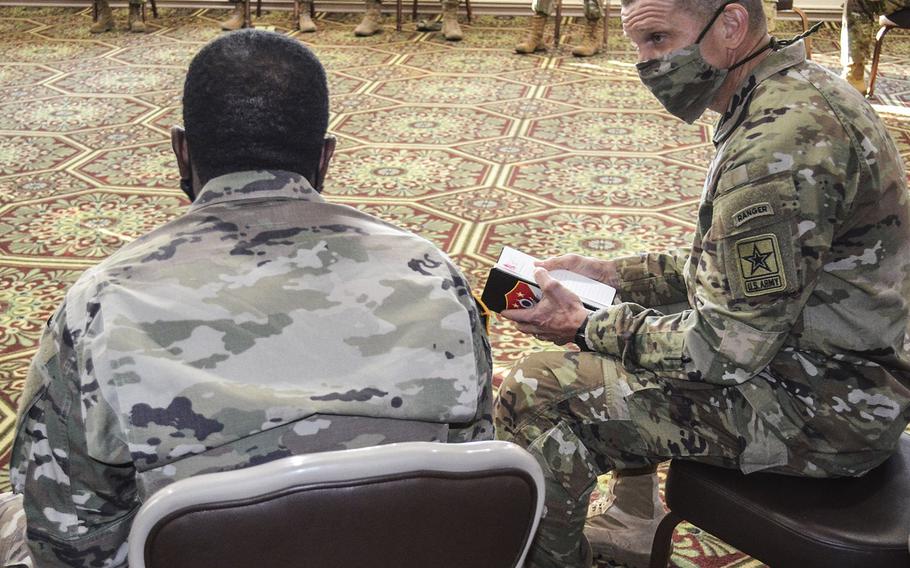
Sgt. Maj. of the Army Michael Grinston met Thursday with junior enlisted soldiers at Fort Hood, Texas, to discuss efforts to improve the base’s command climate and culture after an investigation released last month identified leadership failures and systemic problems. (Rose L. Thayer/Stars and Stripes)
AUSTIN, Texas — Sgt. Maj. of the Army Michael Grinston told a group of soldiers last week at Fort Hood that all the military leaders in Spc. Vanessa Guillen’s chain of command had been fired in the aftermath of her disappearance and death at the base.
On Wednesday, Grinston said some of those soldiers — the seven leaders from her battalion to her squad — have only been suspended until an investigation into what happened is completed. Under a suspension, some of them could return to the unit, according to an Army spokesman.
“They’re gone,” Grinston said Thursday of the individuals when asked by a junior enlisted soldier at the Texas base why soldiers and leaders who commit crimes or allow misconduct to persist are shuffled into new units where they can continue to harm others.
From the squad to battalion, those leaders responsible for Guillen were not there anymore, Grinston said during a discussion with about two dozen soldiers that Stars and Stripes was permitted to attend under the condition that none of the soldiers participating were identified.
But Grinston clarified Wednesday that by saying “gone,” he meant they were suspended. While those leaders have been removed from the unit, they could return to their previous job or other leadership roles in the Army pending the results of an ongoing Army Forces Command investigation. Three leaders from the brigade to corps level were previously announced as fired.
Gen. John Murray, commander of Army Futures Command, was tasked in September with leading that investigation, known in the Army as a 15-6. A public release of its findings has not been scheduled.
The findings of a separate investigation led by civilians were released Dec. 8 and led Army Secretary Ryan McCarthy to take disciplinary action against 14 leaders at Fort Hood, including those Grinston referenced last week. The Fort Hood Independent Review Committee outlined in their report that the command climate and culture problems at the base were a result of poor leadership. Those problems at the base were evident as far back as 2014, according to the report.
Only five of the 14 leaders serving at the brigade-level and above were named in December’s announcement of the disciplinary action, in accordance with Army policy. Maj. Gen. Scott Efflandt, the deputy commander of III Corps, who was the acting base commander at the time of Guillen’s disappearance and death, Col. Ralph Overland and Command Sgt. Maj. Bradley Knapp, the commander and top enlisted soldier of Guillen’s unit, the 3rd Cavalry Regiment, were fired.
Efflandt can retire, if he chooses, or be reassigned at the discretion of the Army chief of staff, and Overland and Knapp will go before separate boards to determine if they can remain on active duty, Under Secretary of the Army James McPherson told the news outlet Task and Purpose.
Maj. Gen Jeff Broadwater and Command Sgt. Maj. Thomas Kenny of the 1st Cavalry Division, which was not part of Guillen’s chain of command, were suspended, pending the results of a new investigation into the unit’s command climate and implementation of a sexual assault prevention program.
Grinston’s visit to Fort Hood last week was meant to check on the base’s initiatives to repair those problems, which began in October and increased following the report’s release.
Each investigation aims to better understand the conditions that led to the killing of Guillen in April, as well as a number of other deaths at Fort Hood that have raised questions about the base’s handling of sexual harassment and assault, missing persons and soldiers’ trust in their leadership.
Guillen, who served as a small arms repairer in the 3rd Cavalry Regiment’s engineer squadron, went missing from the base April 22. Investigators found her body June 30 and determined a fellow soldier, Spc. Aaron Robinson, killed Guillen with a hammer in an arms room, then buried her body about 20 miles from the base.
The deaths of four other Fort Hood soldiers were ruled homicides in 2020. They are among the nearly 30 soldiers who died while assigned to the base, which has a population of about 37,500 active-duty soldiers.
Aside from these two investigations, the Army has at least two more ongoing reviews to understand the conditions at the base and Congress also has an ongoing investigation looking more closely at deaths at the base that some of its member have deemed suspicious.
thayer.rose@stripes.com Twitter: @Rose_Lori